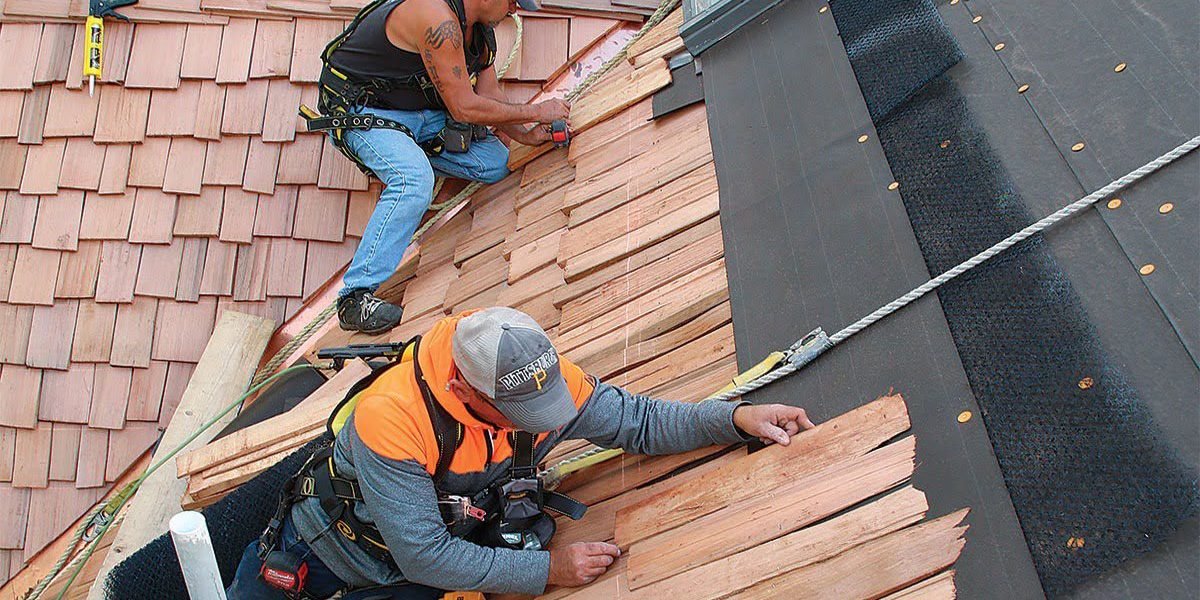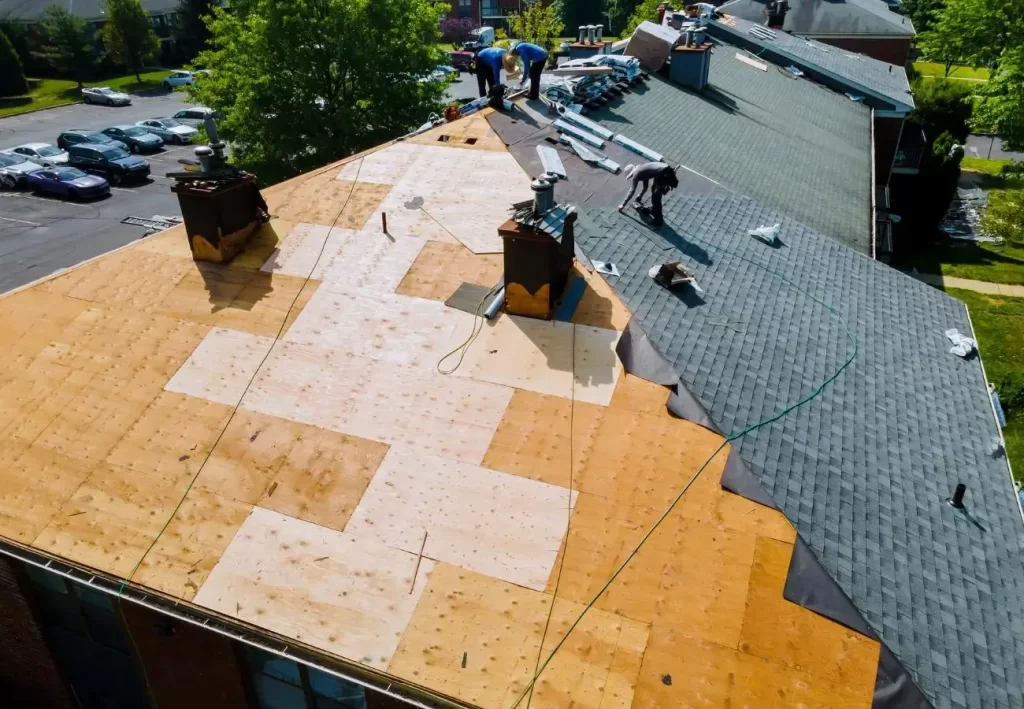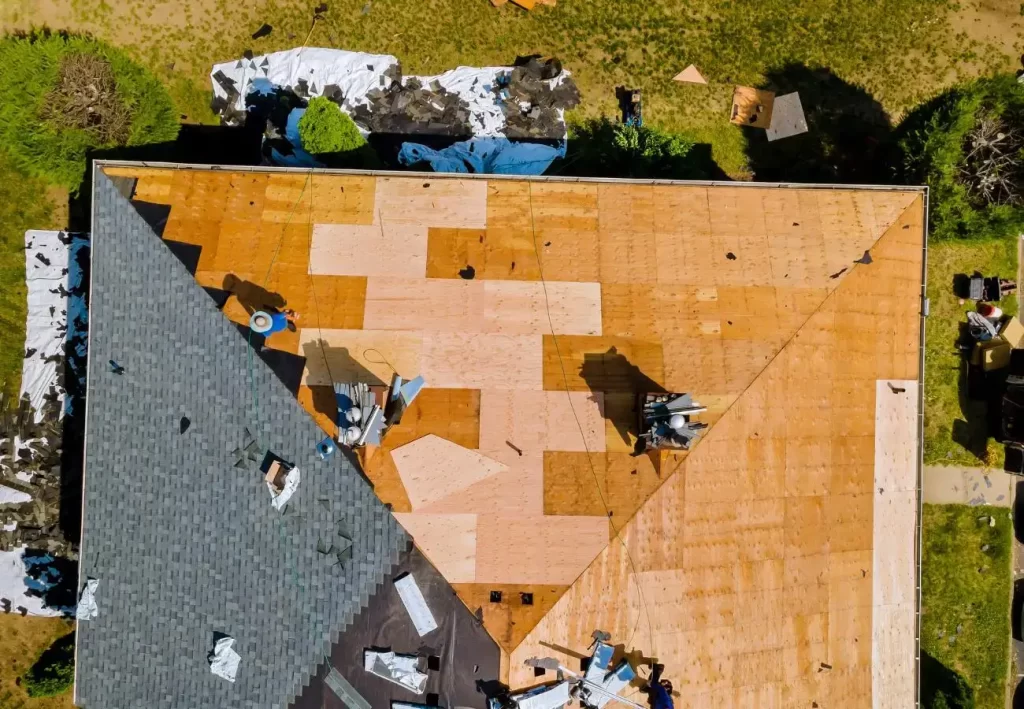A damaged roof can be a major headache, but it doesn’t have to break the bank. Roof replacement with insurance is typically covered under a Replacement Cost Value (RCV) policy, which covers the full or most of the cost to replace the damaged roof with a brand-new version of itself. Insurance companies typically pay the full cost to repair or replace the roof, depending on the terms of the policy.
Many homeowners’ insurance policies cover roof replacement due to covered perils like wind, hail, or falling debris. However, navigating the process and understanding your coverage can be confusing. This comprehensive guide will walk you through everything you need to know about using insurance for a stress-free roof replacement.
We will also provide answers to some frequently asked questions about roof replacement with insurance and how to get insurance to pay for your roof.
Understanding Roof Replacement Insurance Coverage
The two main types of roof replacement coverage offered by insurance are:
- Replacement Cost Value (RCV): This covers the full cost of replacing your entire roof with entirely new materials, even if only a portion is damaged. This is ideal for well-maintained roofs and ensures you get a brand-new, structurally sound roof.
- Actual Cash Value (ACV): This policy pays the depreciated value of your roof at the time of replacement. This may not cover the full cost for older roofs, potentially leaving you with out-of-pocket expenses.
Comparison of Roof Replacement Policies and Costs
Understanding the different types of roof replacement coverage offered by insurance companies is crucial for homeowners. Replacement cost coverage and actual cash value coverage are the two main options, and each has its own advantages and disadvantages.
Replacement Cost Coverage
Pays the full cost to repair or entirely replace your roof with a new one (or similar materials depending on the policy).
- Pros: Ideal for well-maintained roofs, offers maximum protection for replacement costs.
- Cons: Typically more expensive than actual cash value coverage due to its comprehensive nature.
Actual Cash Value Coverage
Pays the depreciated value of your roof at the time of replacement. This means you might receive less than the full cost, especially for older or worn roofs.
- Pros: Often a cheaper option compared to replacement cost coverage.
- Cons: May not fully cover replacement costs, potentially leaving you with out-of-pocket expenses.
Choosing the Right Policy
The best policy for you depends on the age and condition of your roof. Consider these factors:
- Newer or Well-Maintained Roof: Replacement cost coverage offers better protection as it covers the full replacement cost.
- Older or Worn Roof: Actual cash value coverage might be a more cost-effective option, though you might need to pay some out-of-pocket expenses.
Steps to Filing a Claim in NYC or Nassau County
- Document the Damage: Time is of the essence! Take detailed photos and videos of the damage from both inside and outside your home. The more evidence you have, the stronger your claim.
- Contact Your Insurance Company Promptly: Don’t delay! Initiate the claims process immediately and get a claim number. Delays can affect your coverage.
- Hire a Reputable Local Contractor: When choosing a contractor, ensure they are properly licensed to operate in your area and have adequate insurance coverage. Look for experience with your specific roof type and positive customer reviews. Get detailed written estimates outlining the scope of work, materials used, and timeline for completion. Be upfront about any potential out-of-pocket expenses, such as upgrading materials or fixing pre-existing issues.
- Work with the Adjuster: The insurance company will send an adjuster to assess the damage and review the estimate provided by your chosen contractor. They have extensive experience working with adjusters from various insurance companies, ensuring your claim is represented accurately.
- Negotiate and Settle: Review the adjuster’s findings with your contractor. They can help you negotiate a fair settlement to cover the full cost of the roof replacement, according to your insurance policy.
- Begin Repairs: Once everything is finalized, your chosen contractor can begin the work. They’ll ensure a smooth and efficient repair process, minimizing disruption to your daily life.
Costs Involved in Roof Replacement with Insurance
- Deductible: The amount you pay out-of-pocket before insurance kicks in.
- Depreciation (if applicable): ACV policies factor in roof age and wear, potentially reducing coverage.
- Out-of-Pocket Expenses: Upgrading materials or fixing pre-existing issues may incur additional costs.
Conclusion
Replacing a damaged roof with insurance can be a seamless process if you’re well-informed and prepared. By understanding your policy, following the steps outlined, and choosing a reputable local contractor, you can ensure a stress-free roof replacement experience in NYC or Nassau County.
Here’s where you can find a reputable local roofer in NYC and Nassau County:
Brick Tech Contracting Corp is a trusted name in the area, known for our quality workmanship and exceptional customer service. We can provide thorough roof inspections, detailed estimates, and work directly with your insurance company to ensure a smooth claims process. Don’t wait until a small leak turns into a major problem and a potential insurance headache! Schedule a free inspection today to avoid potential future problems and ensure a smooth insurance claim process if necessary.
Frequently Asked Questions Of How Does Roof Replacement Work With Insurance
How Many Shingles Need To Be Missing For Insurance?
Most insurance policies cover the use of “like-kind” materials. If the shingles on your roof have been discontinued and are no longer available, the insurance company will have to replace all the shingles on your roof even if only one shingle is missing. Essentially, no set number of shingles needs to be missing to make an insurance claim.
Does Replacing Roof Increase Value Home?
Yes, replacing a roof can increase the value of a home, especially if the previous roof is old and worn out. It also enhances the curb appeal and provides better protection against weather conditions, thereby improving the overall worth of a property.
Why Does The Contractor Get The Recoverable Depreciation?
The contractor receives the recoverable depreciation check because it covers the remaining cost of the new roof. After completing the roof replacement, the contractor is owed the check as payment. Having a replacement cost value insurance policy enables coverage for most, if not all, of the expenses for a new roof.
How Long Should A Roof Last?
A well-maintained roof can last up to 25 years or more, depending on the materials used and the climate it endures. However, factors such as weather, damage, and poor maintenance can reduce its lifespan. It’s important to have regular inspections and make repairs as necessary to extend the life of your roof.










